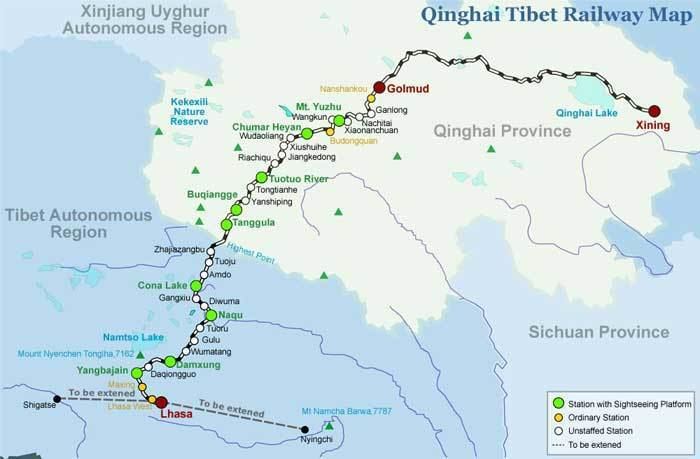 | ||
The Qinghai–Tibet railway or Qingzang railway (Standard Tibetan: མཚོ་བོད་ལྕགས་ལམ།, tr:mtsho bod lcags lam; simplified Chinese: 青藏铁路; traditional Chinese: 青藏鐵路; pinyin: Qīngzàng Tiělù), is a high-elevation railway that connects Xining, Qinghai Province to Lhasa, Tibet Autonomous Region of China.
Contents
- Stations
- Trains and tickets
- Oxygen supply and medical issues
- Construction
- Future extensions
- Golmud to Dunhuang link
- Proposed connection to Nepal
- Potential link to India
- Engineering challenges
- Economic and environmental impact
- Criticism
- Rolling stock
- Scenery from the train window
- References
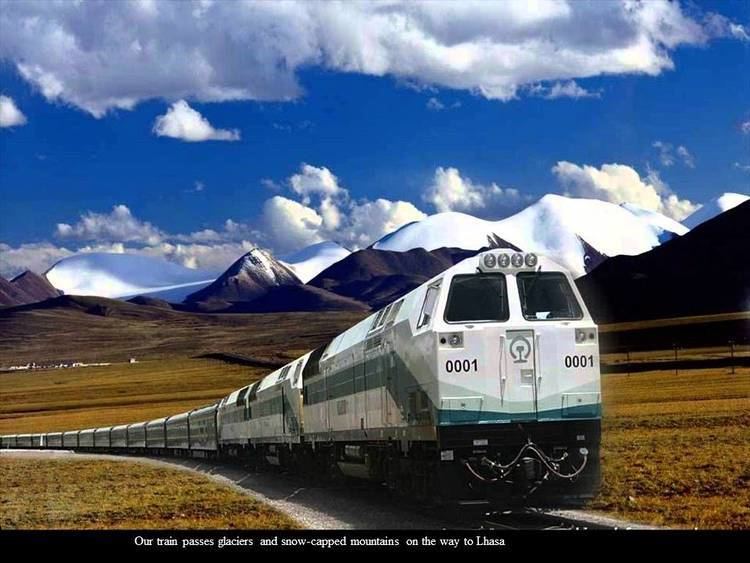
The length of the railway is 1,956 km (1,215 mi). Construction of the 815 km (506 mi) section between Xining and Golmud was completed by 1984. The 1,142 km (710 mi) section between Golmud and Lhasa was inaugurated on 1 July 2006, by Chinese President Hu Jintao: the first two passenger trains were "Qing 1" (Q1) from Xining to Golmud, and "Zang 2" (J2) from Golmud to Lhasa. This railway is the first that connects the Tibet Autonomous Region to any other provinces. Tibet, due to its elevation and terrain, is the last provincial level region in China to have a railway. Testing of the line and equipment started on 1 May 2006. Passenger trains run from Beijing, Chengdu, Chongqing, Guangzhou, Shanghai, Xining, and Lanzhou.
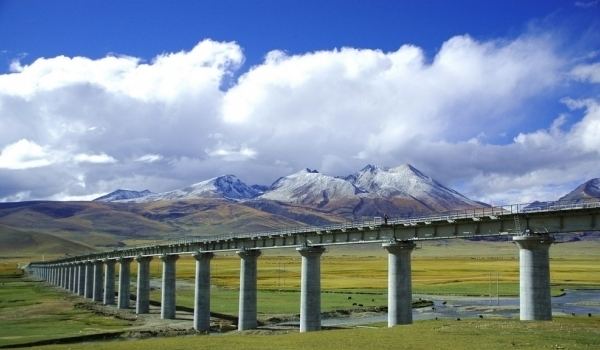
The line includes the Tanggula Pass, which, at 5,072 m (16,640 feet) above sea level, is the world's highest point on a railway. Tanggula railway station at 5,068 m (16,627 feet) 33°00′18.50″N 91°38′57.70″E is the world's highest railway station. The 1,338 m (4,390 ft) Fenghuoshan tunnel is the highest rail tunnel in the world at 4,905 m (16,093 ft) above sea level. The 4,010 m (13,160 ft) New Guanjiao Tunnel is the longest tunnel and the culminating point 3,700 metres (12,100 ft) between Xining and Golmud and 3,345 m (10,974 ft). Yangbajing tunnel is the longest tunnel between Golmud and Lhasa. More than 960 km (600 mi), over 80% of the Golmud–Lhasa section, is at an elevation of more than 4,000 m (13,123 ft). There are 675 bridges, totalling 159.88 km (99.34 mi); about 550 km (340 mi) of track is laid on permafrost.

Stations
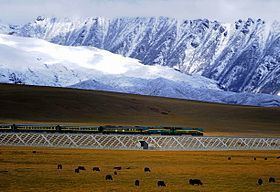
Within the Golmud to Lhasa section of the line there are 45 stations, 38 of which are unstaffed and monitored by the control center in Xining. Thirteen more stations are planned.
Trains and tickets
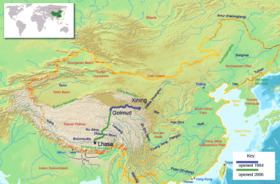
The trains are specially built for high elevation environments. The diesel locomotives were built by GE in Pennsylvania, and the passenger carriages are Chinese-made 25T carriages: on train Z21/Z22, between Beijing West and Lhasa, Bombardier Sifang Transportation (BSP) made carriages on the Golmud-Lhasa section in deep green/yellow or deep red/yellow. Signs in the carriages are in Tibetan, Chinese, and English. The operational speed is 120 km/h (75 mph) and 100 km/h (62 mph) over sections laid on permafrost.
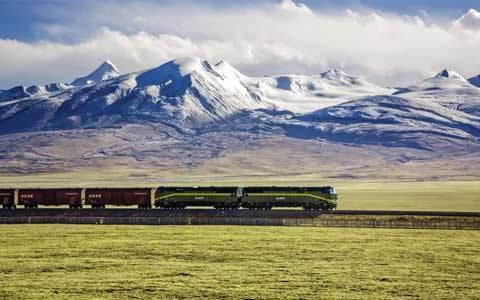
The railway from Golmud to Lhasa was completed on 12 October 2005, and it opened to regular trial service on 1 July 2006.
At the beginning, only three trains ran: Beijing–Lhasa (every day), Chengdu/Chongqing–Lhasa (every other day), and Lanzhou/Xining–Lhasa. Shanghai/Guangzhou–Lhasa service were added in October 2006. In July 2010 the Shanghai–Lhasa service became daily, and a daily service between Xining and Lhasa was added, but the service was then suspended for the winter season.
Since October 2006, five pairs of passenger trains run between Golmud and Lhasa, and one more pair between Xining and Golmud. The line has a capacity of eight pairs of passenger trains.
Oxygen supply and medical issues
The passenger carriages used on Lhasa trains are specially built and have an oxygen supply for each passenger. Every passenger train has a doctor.
A Passenger Health Registration Card is required to take the train between Golmud and Lhasa. The card can be obtained when purchasing the ticket. Passengers must read the health notice for high-elevation travel and sign the agreement on the card to take the train. On 28 August 2006, a 75-year-old Hong Kong man was reported to be the first passenger to die on the train, after he had suffered heart problems in Lhasa but insisted on travelling to Xining.
Construction
The capital of the Qinghai Province, Xining, became connected with the rest of the country by rail in 1959, when the Lanqing Railway from Lanzhou was completed.
The 815 km section of the future Qingzang Railway from Xining to Golmud, Qinghai opened to traffic in 1984. But the remaining 1,142 km (710 mi) section from Golmud to Lhasa could not be constructed until technical difficulties of building railroad tracks on permafrost were solved. This section was formally started on 29 June 2001, finished on 12 October 2005, and signalling work and track testing took another eight months. It was completed in five years at a cost of $3.68 billion.
Track-laying in Tibet was launched from both directions, towards Tanggula Mountain and Lhasa, from Amdo Railway Station on 22 June 2004. On 24 August 2005, track was laid at the railway's highest point, the Tanggula Pass, 5,072 m (16,640 feet) above sea level.
There are 44 stations, among them Tanggula Mountain railway station, at 5,068 m (16,627 ft) the world's highest. Peru's Ticlio railway station at 4,829 m (15,843 ft) is the highest in the Americas (Cóndor station; at 4,786 m or 15,702 ft, on the Rio Mulatos-Potosí line, Bolivia, and La Galera station at 4,777 m or 15,673 ft, in Peru, being the next highest). The Qingzang Railway project involved more than 20,000 workers and over 6,000 pieces of industrial equipment, and is considered one of China's major accomplishments of the 21st century.
Bombardier Transportation built 361 high-altitude passenger carriages with special enriched-oxygen and UV-protection systems, delivered between December 2005 and May 2006. Fifty-three are luxury sleeper carriages for tourist services.
The construction of the railway was part of the China Western Development strategy, an attempt to develop the western provinces of China, which are much less developed than eastern China. The railway will be extended to Zhangmu via Shigatse (日喀则) to the west, and Dali via Nyingchi (林芝) to the east. A further extension is planned to link Shigatse with Yadong near the China-India border (Map ). The railway is considered one of the greatest feats in modern Chinese history by the government, and as a result is often mentioned on regular TV programs. Chinese-Tibetan folk singer Han Hong has a song called Tianlu (Road to Heaven; 天路) praising the Qingzang Railway.
Future extensions
On 17 August 2008, a railway spokesman confirmed plans to add six more rail lines connecting to the Qinghai-Tibet railway, including from Lhasa to Nyingchi and from Lhasa to Shigatse, both in the Tibet Autonomous Region. Three lines will originate from Golmud in Qinghai province and run to Chengdu in Sichuan province, Dunhuang in Gansu province, and Korla of the Xinjiang Uygur Autonomous Region. The sixth will link Xining, the capital of Qinghai, with Zhangye in Gansu. The six lines are expected to be in operation before 2020. Construction work of the Lhasa–Shigatse extension began on 26 September 2010; it was opened in August 2014.
Golmud to Dunhuang link
In October 2012, the beginning of the construction of a 506-km Golmud-Dunhuang railway line was announced. This single-track electrified rail line will run from Dunhuang (in Gansu Province) to the Yinmaxia station on the Qinghai–Tibet Railway north of Golmud. The project is expected to take five years. Since Dunhuang, located in the westernmost part of Gansu, is connected to the Lanxin Railway, the Golmud-Dunhuang link will allow a fairly direct connection between Tibet and Xinjiang.
Proposed connection to Nepal
In a meeting between Chinese and Nepalese officials on 25 April 2008, the Chinese delegation announced the intention to extend the Qingzang railway to Zhangmu (Nepali: Khasa) on the Nepalese border. Nepal had requested that the railway be extended to enable trade and tourism between the two nations. On the occasion of the Nepali premier's visit to China it was reported that construction will be completed by 2020. The section Lhasa-Shigatse opened in August 2014.
Potential link to India
A Chinese Ministry of Railways spokesman announced that it would be extending the Qinghai–Tibet Railway southward to Shigatse, but it has yet to confirm an extension to India, Bangladesh and other railway networks. From time to time, rumors of such a land bridge appear in various newspapers.
The extension to the Shigatse region and Nyingchi has been confirmed by the relevant government departments in Tibet. The Qinghai–Tibet Railway will be connecting close to India. An official in charge of the Tibet Autonomous Region Development and Reform Commission had pointed out: "Tibet Railway is completed, with Lhasa as the basis, will be built east of Lhasa to Nyingchi line from Lhasa to Shigatse west building line of the south building of the Qinghai-Tibet Shigatse to East Asia and other three Railway Line. These extensions will be opened to traffic within a decade. then, the three railway extension will form a large Y-shape, the length will be over two thousand kilometers".
Although the Chinese government never planned an extension to India, many people have remarked on the possibility of this. Qinghai People's Congress Vice Secretary General Liu Palit is one of them. In an interview, 21st Century Business Herald interview, he supported a motion to establish a connection between the Pacific and Indian railway bridge on land, possibly linking the east coast port city of Lianyungang, eastern China, Xi'an, Lanzhou, Xining, Lhasa, Shigatse, through Nepal, and finally arriving in Kolkata and Karachi (Pakistan), China and India and Pakistan to achieve rail transport.
Liu Palit thinks has stated regarding the Qinghai-Tibet Plateau in South Asia continental bridge, "The past is not the Qinghai-Tibet Railway, which route is the only choice, now, starting from Tibet, a land bridge political more meaningful". If the idea of the railway arrived in Nepal's plains region of Nepal, it is very easily connected with the Indian railway network. Experts said that "if the railway opened in Nepal, but also enable the railway system in India and Bangladesh, Nepal and China through connectivity, all countries will benefit."
Engineering challenges
There are many technical difficulties for such a railway. About half of the second section was built on barely permanent permafrost. In the summer, the uppermost layer thaws, and the ground becomes muddy. The heat from the trains passing above is able to melt the permafrost even with a small change in temperature. The main engineering challenge, aside from oxygen shortages, is the weakness of the permafrost. For areas of permafrost that are not very fragile, an embankment of large rocks is sufficient. Meanwhile, in the most fragile areas, the rail bed must be elevated like a bridge. The engineers dealt with this problem in the areas of weakest permafrost by building elevated tracks with pile-driven foundations sunk deep into the ground. Similar to the Trans-Alaska Pipeline System, portions of the track are also passively cooled with ammonia-based heat exchangers.
Due to Climate change, temperatures in the Tibetan Plateau may be considered to increase by an estimated two to three degrees Celsius. This change is sufficient to melt the permafrost and thereby affect the integrity of the entire system. The effects of climate change have yet to be seen.
The air in Tibet is much thinner, with oxygen partial pressure being 35% to 40% below that at sea level. Special passenger carriages are used, and several oxygen factories were built along the railway. Each seat in the train is equipped with an oxygen supply outlet for any possible emergency. The Chinese government claimed that no construction workers died during the construction due to altitude sickness related diseases. The railway passes the Kunlun Mountains, an earthquake zone. A magnitude 8.1 earthquake struck in 2001 (but caused no fatalities). Dozens of earthquake monitors have been installed along the railway.
Economic and environmental impact
With limited industrial capacity in Tibet, the Tibetan economy heavily relies on industrial products from more developed parts of China. Transport of goods in and out of Tibet was mostly through the Qingzang Highway connecting Tibet to the adjacent Qinghai province, which was built in the early 1950s. The length and terrain have limited the capacity of the highway, with less than 1 million tons of goods transported each year. With the construction of the Qingzang railway, the cost of transportation of both passengers and goods should be greatly reduced, allowing for an increase in volume—the cost per tonne-kilometer will be reduced from 0.38 RMB to 0.12 RMB. It is projected that by 2010, 2.8 million tons will be carried to and from Tibet, with over 75% carried by the railway. This is expected to help support the Tibetan economy.
The environmental impact of the new railway is an ongoing concern. The increase in passenger traffic will result in greater tourism and economic activity on the Tibetan Plateau.
Wood is the main fuel source for rural inhabitants in certain regions of Tibet. The damage to the ecosystem caused by cutting trees for fuel takes years to recover due to slow growth caused by Tibet's harsh environmental conditions. The railway would make coal, which is not produced in Tibet, an affordable replacement. However, the increase in fuel combustion due to increased human activity in an already-thin atmosphere may affect the long term health of the local population.
Before the railway, the purchasing power of 100 RMB in Lhasa was only commensurate with 54 RMB in coastal regions of China, mainly due to high transport costs. The railway could elevate the living standards along the railway.
Trash and excrement are collected into two sealed containers in each car (not thrown on the tracks), they are taken out at the big stations.
The effects of this railway on wild animals such as Tibetan antelope and plants are currently unknown. Thirty-three wildlife crossing railway bridges were constructed specifically to allow continued animal migration. Here is the Google Maps satellite image of one such bridge.
There are concerns from the China Meteorological Administration that melting, due to global warming, of the permafrost in Tibet on which part of the railway is placed could threaten the railway within this century.
Criticism
China has been criticized by Tibetan Independence groups for having built the railway to strengthen its political control over Tibet.
In particular, groups such as the International Campaign for Tibet have alleged that the railway will marginalize Tibetans in the Tibet Autonomous Region by encouraging further Han migration from the rest of China.
Rolling stock
Scenery from the train window
Since the opening of Qingzang Railway, the views of the train windows have come to be known to people:
